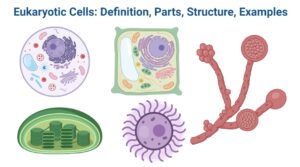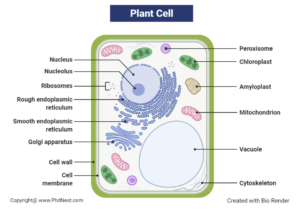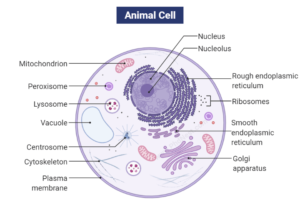Definition of Eukaryotic Cells
Eukaryotic cells feature a membrane-bound, well-defined nucleus as well as several membrane-bound organelles, making them complicated in structure as well as function.
- The term “eukaryote” comes from the Greek words “eu” as well as “karyon,” which mean “true” as well as “nucleus,” respectively.
- When compared to prokaryotes, eukaryotic cells have a more evolved structural makeup.
- Eukaryotic cells can now conduct more complicated roles than prokaryotic cells as a result of these improvements.
Eukaryotic cell characteristics
The following are the general properties of eukaryotic cells:
- Eukaryotic cells are substantially larger than prokaryotic cells, with diameters ranging from 10 to 100 micrometers.
- The morphology of eukaryotic cells varies greatly depending on the cell type. Some cells, like Amoeba, are pleiomorphic, while others, like plant cells, have a fixed shape. Environmental influences, as well as other functional adaptations, have a significant impact on cell shape.
- The cellular organisation of eukaryotic cells is more advanced, with many membrane-bound organelles as well as a well-defined nucleus.
- DNA is the genetic substance of eukaryotic cells, as well as it is linear as well as has several replication origins.
- A complex nuclear membrane surrounds the nucleus of eukaryotic cells. In contrast to prokaryotes, which have circular chromosomes, the chromosomes in the nucleus are complexed with histone protein to form linear chromosomes.
- In certain eukaryotic cells, the cell wall is composed of cellulose or other carbohydrates.
- Certain eukaryotic cells, such as yeast cells, reproduce sexually whereas others reproduce asexually by mitosis or fission.
Eukaryotic cell structure (components/parts)
When compared to prokaryotic cells, eukaryotic cells are substantially larger, having a volume around 10,000 times which of prokaryotic cells. Eukaryotic cells are composed of a number of organelles, both membrane-bound as well asmembrane-less, which in coordination to help the cell’s organisation as well as function.
The following are the common components/parts found in eukaryotic cells:
The cellular wall
- Certain eukaryotic cells, such as protists, fungal cells, as well as plant cells, have a cell wall.
- Plants as well as some protists have cell walls composed of cellulose microfibrils as well as a network of glycans contained in a pectin polysaccharide matrix.
- The cell wall of fungal cells is distinct because it is made up of a different polymer called chitin.
- In eukaryotic cells, however, the function of the cell wall is comparable. Eukaryotic cells are supported as well as shaped by their cell walls.
Membrane of the cell / plasma membrane / cytoplasmic membrane
- In eukaryotic cells, the cell membrane is found within the cell wall.
- The cell membrane serves as the outermost layer which separates the internal contents of the cell from the outside environment in cells which lack a cell wall.
- The plasma membrane is made up of two layers of phospholipids with integral proteins sandwiched between them.
- Eukaryotes as well as prokaryotes have comparable cell membrane compositions.
Cytoplasm
- Cytoplasm of a eukaryotic cell is a fluid-filled area which houses all of the cell’s internal organelles as well as other substances.
- Jelly-like cytosol as well as a water-soluble fluid comprising minerals, ions, as well as other molecules make up the cytoplasm.
- The amount of cytoplasm in eukaryotic cells is more than in prokaryotic cells because eukaryotic cells have a larger cell volume.A eukaryotic cell’s nucleus is an organelle which resides in the cytoplasm.
Nucleus
- A eukaryotic cell’s nucleus is an organelle found in its cytoplasm.
- The nucleus is surrounded by a nuclear membrane which has a comparable composition to the plasma membrane, making it more sophisticated than the prokaryotic nucleus.
- A eukaryotic cell’s genome is found inside the nucleus, where it is linked to numerous proteins such as the histone protein.
- The DNA molecules are structured in chromosomes, which are linear as well as highly orderly, inside the nucleus.
- A nucleolus, which is not covered by a membrane but contains proteins which make up ribosomes as well as rRNA, is also found in the nucleus.
Ribosomes
- Ribosomes in eukaryotic cells are of the 80S type, with 60S as well as 40S subunits.
- The bigger subunit also contains 5S RNA, 28S RNA, as well as proteins, while the smaller subunit only contains 18S RNA as well as 33 proteins.
- Ribosomes are found either connected to the endoplasmic reticulum or free in the cytoplasm of eukaryotic cells.
Plastids and Mitochondria
- Membrane-bound organelles found in the cytoplasm of eukaryotic cells are mitochondria as well as plastids.
- Extrachromosomal DNA affects the activity of the organelles in both mitochondria as well as plastids.
- The exterior membrane of mitochondria is made up of phospholipid bilayers, while the inner layer is folded into cristae, which is where the cell’s major physiological functions take place.
- Plastids are color-producing cells found in eukaryotic cells such as those found in plants as well as algae. Plastids also contain chlorophyll, a green pigment which is necessary for photosynthesis.
Structures of the cytoskeleton
- Many eukaryotic cells include cytoplasmic extensions such as flagella as well as cilia which help them move, eat, as well as sense their surroundings.
- Tubulin proteins are the major constituents of these structures, which are supported by microfilaments as well as microtubules.
- The cytoplasm also contains cytoskeletal structures which give the cell form as well as support.
Eukaryotic cell division (Reproduction)
Certain eukaryotic cells can only split in an asexual manner, while others can split both sexually as well as asexually.
Asexual reproduction
- Instead of reproductive cells whereas make the male as well as female gamete, all eukaryotic cells reproduce asexually.
- Mitosis is the major kind of asexual reproduction, in which a cell doubles in size as well as then split into two identical daughter cells.
- Unicellular fungal cells as well as protists divide via budding, which produces a chain of new cells on the surface of dividing cells.
- Binary as well as multiple fission processes have been seen in primordial eukaryotic cells.
- Some fungi can also split as well as reproduce asexually through sporulation.
Sexual reproduction
- Sexual technique divides the cells of the reproductive system in plants as well as animals.
- The cell was split meiotically in this technique, resulting in four daughter cells, each having half the number of chromosomes as the parent cell.
- Difference in distinct cells is due to sexual reproduction in eukaryotic cells.
Examples of eukaryotic cells
Plant Cell
- Plant cells are eukaryotic cells with a thick cell wall formed of cellulose which gives the cell shape as well as structure.
- A bigger vacuole in the cytoplasm of each plant cell maintains the cell’s turgor pressure.
- Plant cells are also distinct from other eukaryotic cells in which they feature chloroplasts, which contain chlorophyll, which is required for photosynthesis.
Animal Cells
- Animal cells are another eukaryotic cell type which lacks a hard cell wall.
- Absence of a cell wall in animals permits cells to take on diverse forms, which aids phagocytosis as well as pinocytosis.
- Animal cells vary from plant cells in which their vacuoles are smaller as well as they lack chloroplasts.
- Animal cells feature an extra organelle called a centriole, which produces the mitotic apparatus needed for cell division.
Cells of fungi
- Fungal cells have a stiff cell wall, which makes them similar to plant cells.
- The cell wall, on the other hand, is comprised of chitin rather than cellulose.
- Some fungi, like yeasts, are unicellular, with microscopic gaps in their cell membranes which allow cytoplasm as well as other organelles to pass between cells.
Protists
- Protists are single-celled eukaryotes which are more primitive than plant or animal cells.
- The majority of protists lack a cell wall, although few do.
- Many protists have chloroplasts which contain chlorophyll, whereas others may have photosynthetic pigments other than chlorophyll.
- Cilia as well as flagella are cilia as well as flagella which help protists move their cells.
Eukaryotic Cells Citations
- https://www.sarthaks.com/204136/stone-tied-string-length-whirled-vertical-circle-with-the-other-end-the-string-the-centre
- https://www.reference.com/science/centripetal-force-involved-operation-washing-machine-ee15394203b35628
- https://www.meritnation.com/ask-answer/question/a-stone-tied-at-the-end-of-string-is-whirled-in-a-circle-if/laws-of-motion/7284551
- https://www.ielts-mentor.com/writing-sample/writing-task-2/1313-ielts-writing-task-2-sample-323-the-private-motor-vehicle-has-greatly-improved-individual-freedom-of-movement
- https://www.britannica.com/science/centrifugal-force
- https://www.answers.com/Q/What_does_the_mass_of_an_object_depend_on
- https://wikimili.com/en/Centrifugal_force
- https://thenewtonslaw.com/what-is-newtons-second-law-of-motion/
- https://in.answers.yahoo.com/question/index?qid=20080210081429AA8WTcC
- https://byjus.com/physics/centripetal-and-centrifugal-force/
- https://brainly.in/question/8429538
- http://bioedonline.org/lessons-and-more/lessons-by-topic/plants-form-function/how-does-gravity-affect-root-growth/
Related Posts
- Phylum Porifera: Classification, Characteristics, Examples
- Dissecting Microscope (Stereo Microscope) Definition, Principle, Uses, Parts
- Epithelial Tissue Vs Connective Tissue: Definition, 16+ Differences, Examples
- 29+ Differences Between Arteries and Veins
- 31+ Differences Between DNA and RNA (DNA vs RNA)
- Eukaryotic Cells: Definition, Parts, Structure, Examples
- Centrifugal Force: Definition, Principle, Formula, Examples
- Asexual Vs Sexual Reproduction: Overview, 18+ Differences, Examples
- Glandular Epithelium: Location, Structure, Functions, Examples
- 25+ Differences between Invertebrates and Vertebrates
- Lineweaver–Burk Plot
- Cilia and Flagella: Definition, Structure, Functions and Diagram
- P-value: Definition, Formula, Table and Calculation
- Nucleosome Model of Chromosome
- Northern Blot: Overview, Principle, Procedure and Results



















